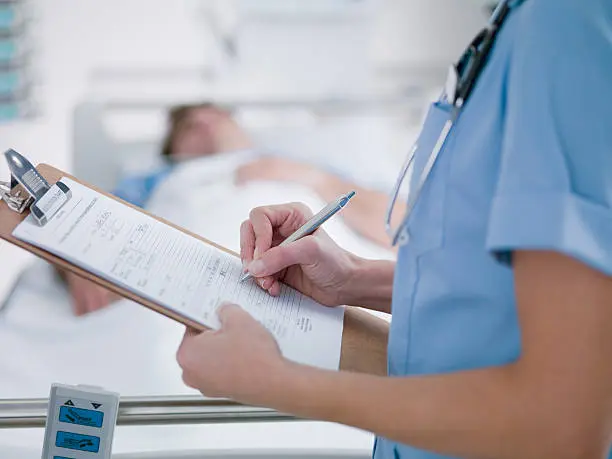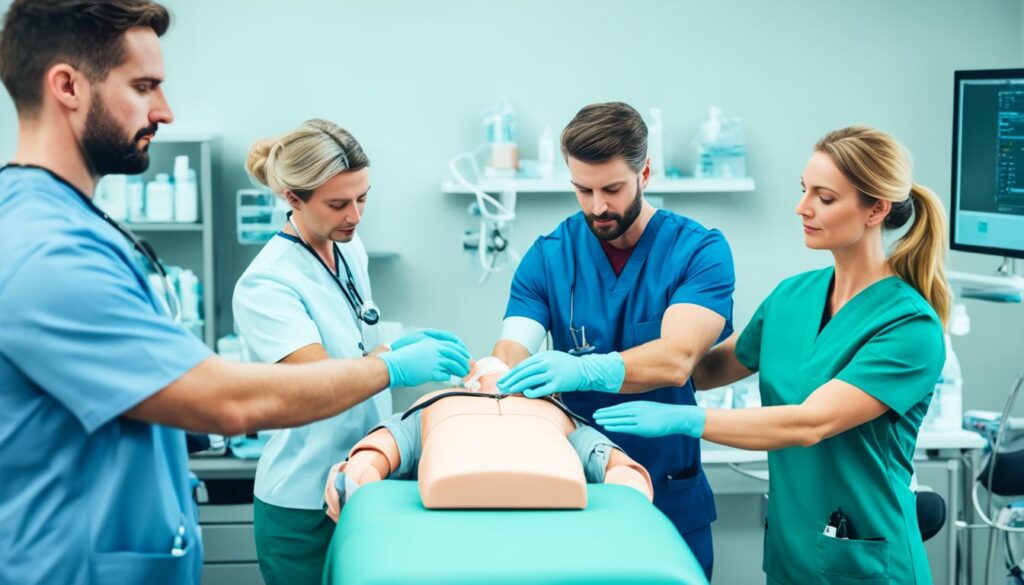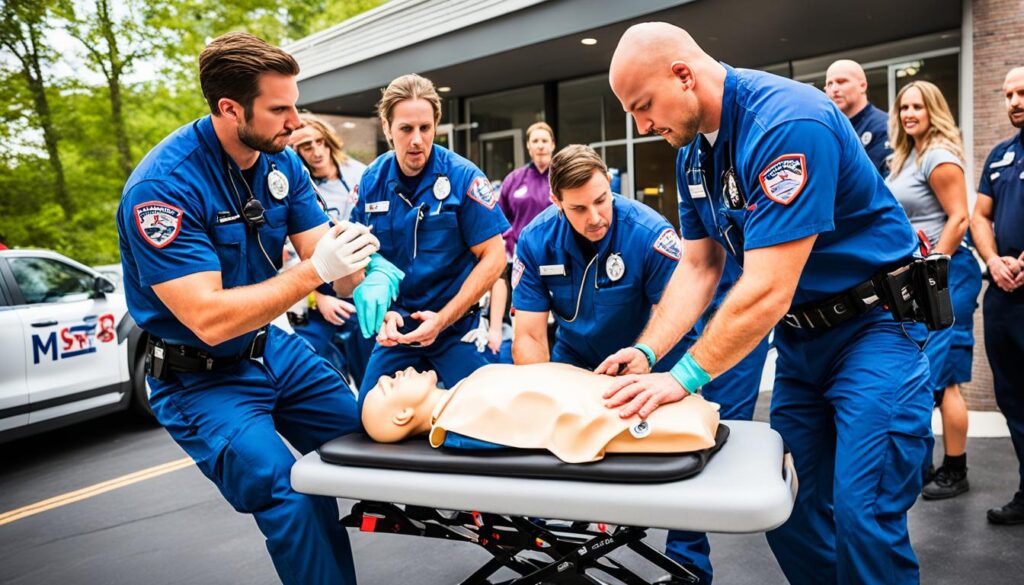
BLS Course: Essential Life-Saving Skills Training
Have you ever thought about what skills healthcare workers need to save lives in emergencies? The American Red Cross Basic Life Support (BLS) course is the key. It teaches healthcare workers, first responders, and safety staff how to quickly check for problems, do CPR, and handle many medical emergencies.
Key Takeaways
- The BLS course is for healthcare pros like nurses, doctors, EMS, and public safety teams.
- It covers quick checks, CPR/AED for adults, kids, and babies, blocked airways, and opioid overdoses, and more.
- BLS certification comes with digital credentials that have unique IDs and QR codes for easy check by employers.
- This training is different from First Aid, focusing on bringing people back to life and managing airways.
- It’s key for meeting healthcare job needs, education, and getting certified.
So, what makes the American Red Cross BLS course stand out? And why is it a must-have for healthcare workers? Let’s look into the main parts that make this training vital for saving lives.
Introduction to BLS Training
Basic Life Support (BLS) training is key in healthcare and emergency response. It’s given by groups like the American Red Cross. BLS courses teach people how to do CPR, use an AED, and handle medical emergencies well.
What is a BLS Course?
A BLS course teaches healthcare workers and safety experts how to save lives. It covers many topics, like science, thinking on your feet, working as a team, and making quick decisions.
Healthcare pros like nurses, doctors, and EMS workers need BLS training. They learn to help people in trouble, whether they’re adults, kids, or babies. They use the newest methods and guidelines.
Importance of Life-Saving Skills
Learning to save lives is very important. Heart disease is the top cause of death in the U.S. Quick action can really help people survive and avoid serious health issues later.
BLS training also meets work and law needs. It makes sure healthcare workers and first responders can deal with many emergencies. It’s a must for those in high-risk jobs or who might have to act fast in an emergency.
“The true measure of any society is how it treats its most vulnerable members.” – Mahatma Gandhi
After a BLS course, people can be sure, skilled, and caring first responders. They’re ready to give life-saving care when it’s needed most.
Who Should Take a BLS Course?
The American Heart Association’s Basic Life Support (BLS) course is for many people. It teaches CPR and other life-saving skills. It’s great for healthcare workers, emergency responders, teachers, and anyone wanting to help in medical emergencies.
Almost anyone can take a BLS course. It’s perfect for healthcare workers, emergency responders, teachers, police, lifeguards, construction workers, therapists, and fitness trainers. You get certified for two years, keeping your skills sharp with the latest techniques.
In-person classes last about four hours. Online classes are more flexible. They’re also affordable, making it easy for many to join. The American Academy of CPR and First Aid, Inc. and the American Red Cross offer these courses.
| Profession | Importance of BLS Certification |
|---|---|
| Healthcare Providers | BLS certification is essential for medical professionals, including doctors, nurses, medical assistants, EMTs, and paramedics, to provide immediate lifesaving care in emergency situations. |
| Emergency Responders | First responders, such as police officers, firefighters, and lifeguards, need BLS training to effectively respond to cardiac emergencies and other medical crises in the field. |
| Educators | Teachers, coaches, and other educators should have BLS certification to ensure the safety of their students and athletes in the event of a medical emergency. |
| General Public | Anyone can benefit from BLS training, as it equips individuals with the skills to provide immediate assistance in a wide range of medical emergencies, ultimately saving lives. |
Whether you’re in healthcare, emergency services, or just want to help in emergencies, a BLS course is key. It gives you the skills and knowledge to save lives. With flexible training and low costs, getting certified is a smart move for your career and personal growth.
BLS Course Objectives
The BLS (Basic Life Support) course from the American Red Cross teaches healthcare workers and public safety pros key life-saving skills. It’s based on the latest international consensus on CPR and emergency care. This ensures participants get the best training available.
This course focuses on critical thinking, teamwork, and problem-solving. It covers lifesaving procedures like CPR, AED use, and how to clear airway blockages in adults, kids, and babies. You’ll also learn about cardiac care and resuscitation techniques for breathing and medical emergencies.
The American Red Cross offers the BLS course in blended learning and classroom training. Both methods give you the same AHA-approved training and a BLS Course Completion Card. This means you’ll get the first aid skills and emergency response knowledge to help in critical situations.
| BLS Course Objectives |
|---|
|
“The BLS course equips healthcare providers and first responders with the essential skills and knowledge to save lives in critical situations. By mastering these life-saving techniques, participants can make a real difference when it matters most.”
BLS Course for Healthcare Providers
The basic life support (BLS) course is for healthcare workers like EMTs, paramedics, firefighters, and hospital staff. It teaches them how to give immediate care in emergencies. This training is key for saving lives.
After finishing the BLS course, students get a 2-year BLS Provider certification from the American Heart Association. The course stresses the need for teamwork, clear communication, and a system for care in urgent situations. These situations include heart arrest, stroke, and heart attacks.
The course teaches important skills like recognizing and handling heart arrest, CPR for all ages, and using an AED. It also covers how to spot early signs of heart attack and stroke. Through real-life scenarios, it helps train healthcare workers to think and act fast in emergencies.
| Course Details | Cost |
|---|---|
| BLS Course for Healthcare Providers | $65.00 |
| Required BLS Book | $20.00 |
| Reschedule Fee | $25.00 |
| Student Discount (First Lady Permanente program) | $50.00 |
The BLS course is offered in many states and locations, with classes from Monday to Friday. This makes it easy for people to find a time that works for them. On-site group training is also available for groups of five or more, which is great for hospitals and clinics.
The BLS curriculum is updated regularly to keep up with new research and guidelines. This means healthcare workers get the latest training. By taking the BLS course, they show they’re serious about giving top-notch emergency care and saving lives.
BLS Course: Scenario-Based Learning
The American Heart Association’s bls course uses a scenario-based method to teach critical thinking and problem-solving. This cpr training program focuses on teamwork, communication, and spotting and handling life-threatening conditions. Conditions like cardiopulmonary arrest, stroke, and heart attacks are covered.
The bls course includes 10 interactive scenarios to test your first aid skills and emergency response knowledge. These scenarios make you practice cardiac care, resuscitation techniques, and other lifesaving procedures in real-life situations.
There’s also a quiz to check your understanding of important topics like starting care in a heart emergency and using AEDs correctly. Passing the 11-question quiz shows you’re ready to give top-notch, life-saving care.
This course doesn’t just teach you facts. It also helps you think critically and make smart choices in emergencies. It’s designed for healthcare workers, first responders, and others to save lives by giving them the right skills and confidence.
“The BLS Provider (CPR for Healthcare Professionals) course is about 5 hours long. It lasts for two years. This shows you’re serious about giving top-quality care and ready to handle heart emergencies with confidence.”
BLS Course and the AHA Guidelines
The Basic Life Support (BLS) course follows the latest American Heart Association (AHA) guidelines. It teaches the newest lifesaving techniques. This ensures participants get the best training available.
The course covers many emergencies like CPR, AED use, and how to clear airways for adults, kids, and babies. It prepares healthcare workers and first responders to handle different emergencies. They learn from the AHA’s detailed guidelines.
High-quality chest compressions are a big part of the BLS course. Students learn the right way to press on the chest to help a patient in cardiac arrest. They also learn about advanced airway care to make sure patients breathe and get enough oxygen.
The course also teaches how to use defibrillators and AEDs. This training helps healthcare workers and first responders quickly treat serious heart problems. They learn to spot and treat dangerous heart rhythms.
| Key AHA BLS Guidelines Covered in the Course | Details |
|---|---|
| CPR and AED for Adult, Child, and Infant | Covers 1-Rescuer CPR and AED use for adults, children, and infants. |
| Rescue Breathing | Teaches proper rescue breathing techniques for adult, child, and infant patients. |
| Airway Management | Covers bag-mask techniques and relief of choking for adult, child, and infant patients. |
| CPR with Advanced Airway | Introduces compression/ventilation rate and ratio for patients with an advanced airway. |
The BLS course keeps up with the AHA’s latest guidelines. This means healthcare workers and first responders get the newest, most reliable training. The course is all about using the latest research and best practices in emergency care.
“Effective CPR and AED care can more than double a person’s chance of survival during a cardiac emergency.”
BLS Course: Critical Thinking and Problem-Solving
The BLS (Basic Life Support) Course teaches more than just life-saving skills. It uses real-life scenarios to improve critical thinking and problem-solving. These skills are key for the best patient care. The course focuses on teamwork, clear communication, and the systems needed for emergency care.
Students in the BLS Course face challenging scenarios that test their quick thinking. They learn to handle emergencies like cardiac arrest and strokes. This hands-on training prepares them for the tough situations they might face in real life.
The course stresses the importance of teamwork and communication. It teaches students to work well together as a team. This is crucial in real emergencies where BLS skills are essential. It helps them work together smoothly to save lives.
After finishing the BLS Course, healthcare workers and first responders can think and solve problems better. They learn to make fast decisions and use the right resuscitation techniques and lifesaving procedures. This training helps them improve medical emergency outcomes.
“The BLS Course is not just about learning the technical skills – it’s about developing the cognitive abilities to think clearly, prioritize, and problem-solve under immense pressure. This training is essential for anyone working in the healthcare or emergency response fields.”
– Dr. Emily Keller, Emergency Medicine Specialist
| Program Details | BLS Course |
|---|---|
| Program Fees | $55 |
| Class Length | Up to 6 hours |
| Class Size | Limited to 6 students |
| Scheduled Dates |
|
BLS Course for EMTs and First Responders
Basic Life Support (BLS) courses teach EMTs, paramedics, firefighters, and other first responders key skills. These skills help them save lives in medical emergencies. These courses are more in-depth than CPR training for the public.
After finishing a BLS course, students get a two-year course completion card. This card shows they know how to do CPR, use an AED, and handle airway and breathing problems.
The BLS course for EMTs and first responders includes important topics:
- Cardiac care and resuscitation techniques
- Airway management and respiratory support
- Recognizing and responding to medical emergencies
- Effective communication and teamwork in emergency situations
- Hands-on practice with medical equipment and lifesaving procedures
These courses follow the latest guidelines from the American Heart Association (AHA) and other top health groups. This means EMTs and first responders learn the newest, most effective ways to care for emergencies.
| Course Offerings | Course Details | Certification Credits |
|---|---|---|
| Medic Monthly Online Training Series | Video-based courses focusing on case-based scenarios for EMTs and first responders, covering topics such as asthma, carbon monoxide poisoning, chest pain, and stroke. | Each module provides 1.0 hour of Continuing Education (CE) credit. |
| ProTrainings BLS Course | Blended learning program with online and hands-on training components, covering cardiac care, airway/respiration/ventilation, and medical/clinical scenarios. | Nurses can receive up to 4 Continuing Education (CE) Credits. |
By taking a full BLS course, EMTs and first responders boost their emergency response skills, lifesaving procedures, and medical emergency management skills. This helps them do a better job in the field, saving more lives.
“The BLS course has been an invaluable resource for our EMT team. The hands-on training and scenario-based learning have empowered us to respond to critical situations with confidence and expertise.”
BLS Course and Team Dynamics
The BLS (Basic Life Support) course teaches the key role of teamwork and clear communication in medical emergencies. It covers the importance of systems of care, recognizing and acting on cardiopulmonary arrest, immediate post-cardiac arrest, acute dysrhythmia, stroke, and acute coronary syndromes (ACS).
Teams with skilled healthcare workers can boost the success rate of resuscitation. It’s crucial that each team member knows their role and the steps to take. They should also practice their skills well.
Key Roles in the Resuscitation Team
The BLS course stresses the need for each team member to know their role in a resuscitation. The six main roles are:
- Team Leader: Leads the team, guides members, makes treatment choices, and keeps an eye on the team’s work.
- Compressor: Does chest compressions, changes positions to avoid getting tired, and keeps up the quality of compressions every two minutes.
- Airway Manager: Takes care of the patient’s airway, uses the right equipment, and keeps it open.
- AED/Monitor/Defibrillator: Brings and uses the AED, helps with chest compressions, and shares duties.
- IV/IO Medications Provider: Sets up vascular access, gives out medications on time, and gives feedback when needed.
- Time Recorder: Tracks the time for all actions, gives out medications, and tells the team when it’s time for the next step.
High-quality CPR is key for successful resuscitation, making sure compressions are deep and at the right rate.
Learning and practicing these team dynamics in the BLS course prepares participants for medical emergencies. It helps them work well in a team and improve patient care.
BLS Course: Renewal and Recertification
Keeping your bls course certification current is key for healthcare workers, first responders, and others needing basic life support and cpr training. After finishing the BLS course, you get a card that lasts two years. It’s important to renew this certification to keep your skills sharp for medical emergencies and lifesaving procedures.
The BLS course renewal is easy and flexible. If you want to renew your healthcare certification, there are quick review courses. These are for those who already have a current or recently expired American Red Cross BLS certification.
To renew, you just need to pass an online test with at least 70 points. The test covers CPR and AED use, and how to help someone with an blocked airway. Once you pass, you get a digital certificate with a QR code for easy access to your healthcare certification.
| Renewal Course Details | Information |
|---|---|
| Renewal Cost | $14.95 |
| Renewal Duration | 45 minutes |
| Renewal Period | 2 Years |
| Number of Modules | 13 |
| Recertification Test Questions | 10 |
| Minimum Passing Grade | 70 points (7/10 correct answers) |
| Recertification Cost | One-time fee of $14.95 |
| Exam Attempts Allowed | Unlimited |
| Shipping Time for Wallet Card | 2 to 5 business days |
Having a valid BLS certification is a must for professionals and a personal pledge for public safety. By updating your basic life support skills, you’re ready to act fast in emergencies. This could save lives and make a big difference in your community.
“Renewing your BLS certification is a small investment that can have a massive impact on the lives of those you encounter in times of crisis.”
For healthcare workers, first responders, or anyone interested in lifesaving procedures, renewing your BLS course is easy and keeps you current with the latest emergency response methods. It’s your duty to keep your healthcare certification current. This way, you’re ready to help quickly and effectively when emergencies happen.
Conclusion
The BLS Course teaches you how to save lives in medical emergencies. You’ll learn key skills like CPR, AED use, and how to manage airways. This makes you ready to help and increase the chance of survival until help arrives.
This training covers how to help adults, children, and babies. It also stresses the value of teamwork, clear communication, and following care systems. It’s great for healthcare workers, first responders, or anyone in the community. The BLS Course trains you to act fast and right in emergencies.
After finishing the BLS Course, you’ll know how to help others and feel confident in your abilities. You’ll be a hero in your community. Take this chance to make a big difference and help keep everyone safe.


